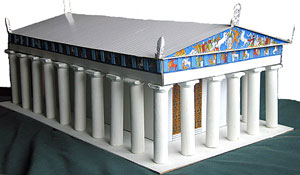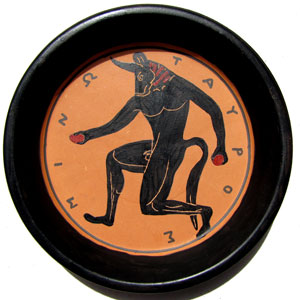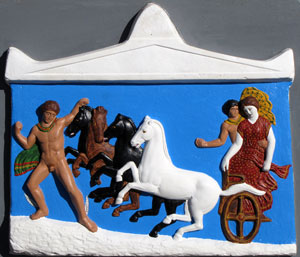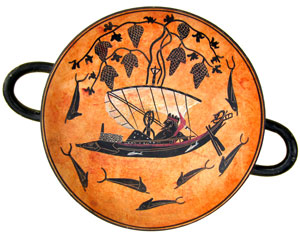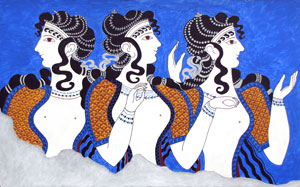
A workshop on the artistic achievements of the Ancient Greeks, for year 4-6
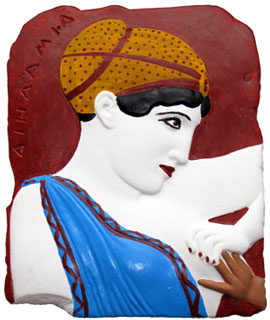
Relief of a woman, Deidamia - one of the painting options
This lesson is a very hands-on way to learn about Greek art and architecture and their influence on the modern world. Children will love creating their own works of art, and at the end of the day you can make your own amazing Greek museum.
The lesson lasts all day (from 9.30) and takes place in your classroom.
Testimonials
'The class had a fantastic time. They learnt a lot during the day and
thoroughly enjoyed themselves.'
Y5 Teacher, Norris Bank Primary
Main activities:
1. Learn about styles of Greek art: Minoan, Geometric, Archaic, Classical, with game
2. Make Greek art: pottery paintings, sculpture paintings, Minoan frescoes
3. Learn about Greek temple architecture, with games
4. Make a model of the Parthenon
Model of the Parthenon made in the workshop (click for larger version)
Fee: £239 for a whole day, discounts available for small classes. Maximum 34 children per class.
To book, email Tony North: tnorth67@hotmail.com or tel: 0161 224 6445
Background information:
Terracotta saucer painted as a Greek wine cup - one of the options for the art session (click to see actual size)
Parthenon posters for sale at workshops
Photos of workshops
Photos from a Greek Art lesson at Manchester Muslim Prep School, Sept 2015
The Legacies of Ancient Greece
The ancient Greeks gave the world many wonderful innovations, such as democracy, science, philosophy and theatre. This workshop focuses on two of their greatest gifts: art and architecture.
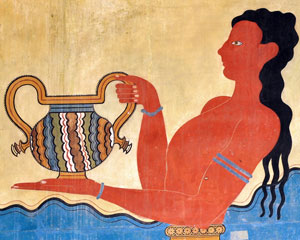
Minoan fresco (reconstruction) of a man bearing a vase
During the first millennium BC Greek art went through such a profound change it has been called 'the Greek revolution'. In Minoan times (around 1500BC) depictions of people and nature were influenced by Egyptian art - colourful, beautiful, but not realistic in a photographic sense. Then, beginning with the Archaic period (around 700BC), the Greeks began to represent life, especially the human form, in a much more realistic manner.

Discobolos - Roman copy of Greek original
By the 400s, in the 'Classical' period, the Greeks had invented a wholly realistic style which can be seen for example in the famous Parthenon sculptures. Striking poses, believable bodies with accurate muscles and even veins, and flowing, rippling robes, all gave life to statues as well as pottery paintings. This style was developed in later centuries and rediscovered in the Rennaissance, leading to our modern conception of classical art.


Modern reconstructions of painted Greek sculpture
What many people don't realise is that added naturalism was given to sculpture by painting. Statues and temple reliefs were far more colourful than they appear today in museums.
Another important legacy was styles of architecture. Greek temples such as the Parthenon, with their beautifully modelled columns, pediments, and friezes inspired the Romans, and much later, modern European and American architects. Nowadays most city centres and mansions are replete with Greek/Roman designs, and we associate this style with grandeur, harmony, and a sense of timelessness.
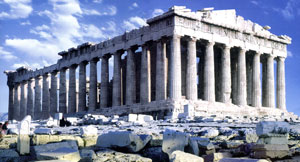
In this lesson children learn about these legacies through photos, games, and above all making their own versions of Greek art as well as a model of the Parthenon in its heyday, with full colour and its monumental statue of Athena, plated in gold and ivory.
Detailed lesson plans are provided to the right.
To book, contact:
Tony North
0161 224 6445/07754 406422
Artefacts used in the art game:
Relief showing the abduction of a nymph (original in Athens) (click for larger version)
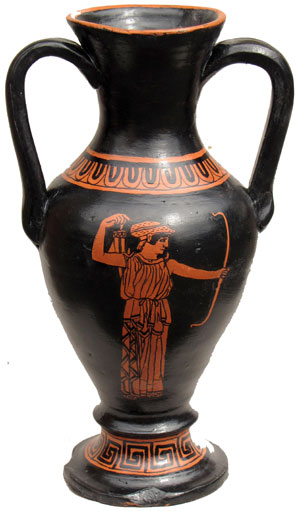
Red figure vase showing the goddess Artemis
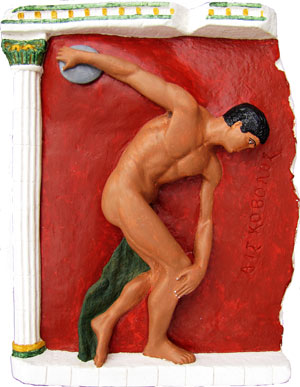
Relief of the discus thrower
Kylix (wine cup) with black figure painting of the god Dionysus
(click for larger version)
Minoan frieze showing 3 women (click for larger version)
Lesson Plan: Morning
1. Architecture (30 mins)
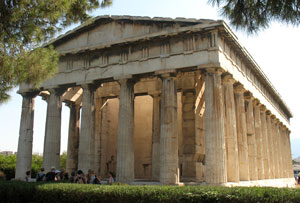
The temple of Hephaestus in Athens
Look at photos of the Parthenon and other temples, to learn about these amazing buildings and their architecture. Learn about the 12m high golden statue of Athena, and the exact copy of the Parthenon in America. Compare ancient temples with modern buildings to see the influence on modern architecture.

The Birmingham town hall
Learn about the parts of a temple (column, capital, cella, entablature, metope, triglyph, pediment) and the 3 main types of column (Doric, Ionic, and Corinthian) using photos, paintings and models.
Play game using photos: identify the type of column.
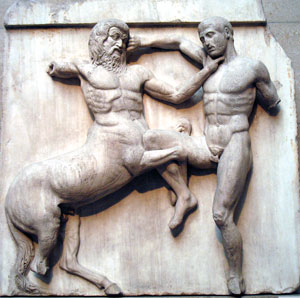
Metope from the Parthenon, in the British Museum
2. Make a model of the Parthenon (60 mins)
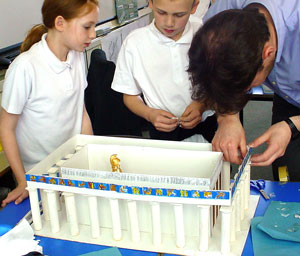
Children work in groups to make the various parts of the temple, with two acting as architects, sticking all the parts together. The model is about 60cm long and made from a wooden base, wood, plasticine, foam card and acrylic paint for the columns, and thick white card for the main body of the temple.
Pictures of temple making at various schools
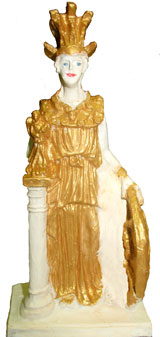
Statue of Athena (painted by y4 children)
Because the sculpture was painted, children use felt tips to colour in outlines. Corrugated card is used for the triglyphs. Two children paint a scale model of the statue of Athena gold (see above).
The finished model is very impressive and will look fantastic by the side of your classroom.
Click for larger version
3. Introduction to Greek Art (30 mins)
Before lunch we learn about the styles of Greek art and how they developed through time, by looking at photos. We begin with Minoan frescoes and vase paintings (around 1500BC), from Crete and the nearby islands.
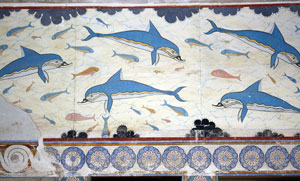
the famous dolphin fresco at Knossos
The Minoans were strongly influenced by Egyptian art which showed people from different points of view (e.g. face in profile but eyes from the front). See my own copies of Minoan frescoes here.
Next we take a quick look at Geometric art (c.900-700BC) in which there was little large sculpture. Pottery was painted with geometric patterns and eventually crude stick-figures of people.
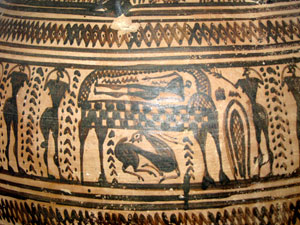
Geometric period vase painting (showing a funeral)
Third is the Archaic period (c.700-480BC) in which statues of young men and women were carved in an increasingly realistic style. At first the poses were again Egyptian-influenced, very stiff and square, arms by the sides and one leg forward.


Greek kouros (young man) and Egyptian man statues
Pottery painting too became more sophisticated. The Archaic period is known for the 'Black figure' style, in which the subject was painted in a clay slip which turned black with firing, while the background remained a clay colour (varying from beige to reddish-orange). Lines were inscribed with a sharp tool and red and white details could be added.

Black figure vase showing Odysseus blinding the cyclops
Geometric vase

Relief of running hoplite used in game
Also one of the options for the art session
Lesson plan continues in next column
Finally we look at the classical period (480-330BC) in which Greek art perhaps reached its peak. Sculpture was much more realistic, and varied in pose and orientation. Statues were carved in marble or cast in bronze, although sadly few bronze statues have survived the centuries.
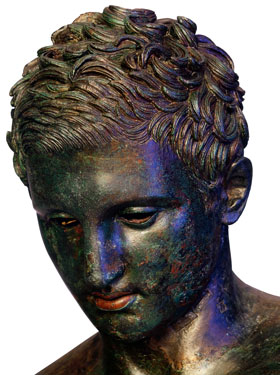
Head of a bronze statue of a boy
Pottery painting turned to the 'Red figure' style, in which the background was black and the figure left the orange colour of the clay. Lines were now painted very thinly in black, which allowed for more detailed and realistic representations.
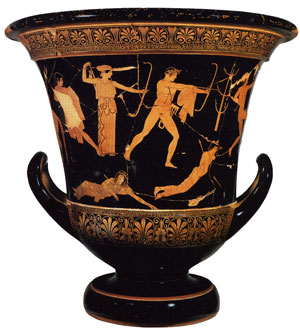
Red figure vase showing Artemis and Apollo
Lesson Plan: Afternoon
4. Greek Art Game (10 minutes)
To help children understand these four styles of art we now play a game. Children are split into 7 teams to look at 7 replicas of Greek art. In each case they must identify (a) the art period, and (b) any gods (4 are present). Each child in the winning team will get a free Parthenon poster. The 7 items can be seen below. All except the kylix and the geometric vase were painted by me.

5. Make Greek Art (90+ minutes)
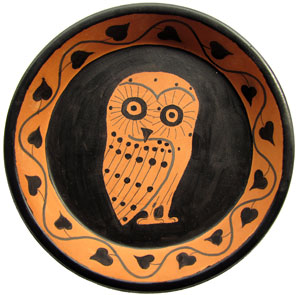
In the main part of the morning session, children create authentic replicas of 4 kinds of Greek art: vase paintings on clay tiles (20X20cm, up to 8 provided), kylix (drinking cup) paintings on clay saucers (19cm wide, up to 4 provided), relief paintings (on plaster casts, up to 8 provided), and Minoan frescoes (on 24X30cm wooden boards already painted white, up to 14 provided).
An art lesson will be given first, and then careful one-to-one guidance during the session, to ensure children create beautiful works of art. Each child has their own item, with 4 levels of difficulty to suit the needs of your class.
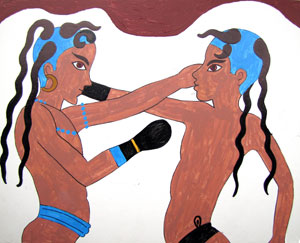
Minoan fresco of boys boxing, from Santorini
The procedure
The reliefs are simply painted, but for the other items there are several steps:
(a) Choose a design. Many options are provided, including both red-figure and black-figure for the pottery paintings. Examples are given on this page but many more can be seen here.
(b) Draw round a template in pencil. Then go over the lines with a thin black permanent marker.
(c) Paint background colours - black for the pottery paintings. Acrylic paint is used.
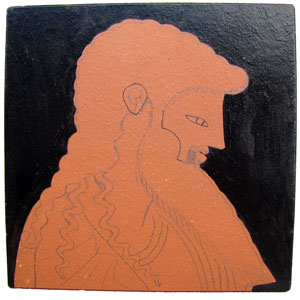
(d) Do details with pencils first, then marker pens, special paint pens. On the saucers, lines can be inscribed with a dart.
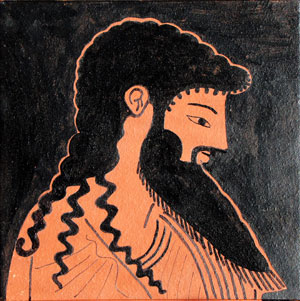
Red figure painting of Zeus
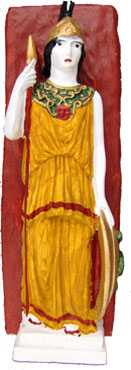

Reliefs of Athena and Aphrodite
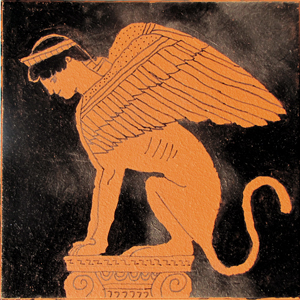
Pottery painting of the sphinx by a Y6 girl
